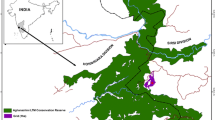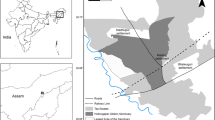Abstract
Temporal changes in food availability affect foraging success and ultimately reproductive success of animals. They include both seasonal and annual changes. Although many researchers have investigated food availability and the corresponding ranging behavior of primates, studies of yearly changes have been limited. We studied the effects of the fruiting of nuts of Fagus crenata, Zelkova serrata, and Torreya nucifera on the ranging behavior of Japanese macaques (Macaca fuscata) in autumn on Kinkazan Island, northern Japan, for 5 yr between 2000 and 2005 (excluding 2003). We divided the study area (3.3 km2) into 100 × 100-m quadrats to assess the distribution of nut-rich quadrats that contained high densities of nut-producing species. The home ranges of the monkeys contained more nut-rich quadrats than expected, and the difference was significant for 3 of 5 yr. Autumn home-range use was also affected by the distribution of nut production, although the effect differed by year: monkeys frequently used nut-rich quadrats in a Zelkova-year (2000) and in 1 Torreya-year (2001), whereas they nonselectively used nut-rich quadrats in 2 Fagus-years (2002 and 2005) and in another Torreya-year (2004). Thus, Japanese macaques flexibly change their autumn ranging behavior according to yearly changes in distribution of nut production.




Similar content being viewed by others
References
Brain, C. (1990). Spatial usage of a desert environment by baboons (Papio ursinus). Journal of Arid Environments, 18, 67–73.
Bronikowski, A. M., & Altmann, J. (1996). Foraging in a variable environment: Weather patterns and the behavioral ecology of baboons. Behavioral Ecology and Sociobiology, 39, 11–25. doi:10.1007/s002650050262.
Clutton-Brock, T. H. (1975). Ranging behaviour of red colobus (Colobus badius tephrosceles) in the Gombe National Park. Animal Behaviour, 23, 706–722. doi:10.1016/0003-3472(75)90147-5.
Clutton-Brock, T. H. (1977). Some aspects of intraspecific variation in feeding and ranging behavior in primates. In T. H. Clutton-Brock (Ed.), Primate ecology: Studies of feeding and ranging behaviour in lemurs, monkeys, and apes (pp. 539–556). London: Academic Press.
Di Bitetti, M. S. (2001). Home range use by the tufted capuchin monkey (Cebus apella nigritus) in a subtropical rainforest of Argentina. Journal of Zoology, 253, 33–45. doi:10.1017/S0952836901000048.
Dobson, A. P., & Lyles, A. M. (1989). The population dynamics and conservation of primate populations. Conservation Biology, 3, 362–380. doi:10.1111/j.1523-1739.1989.tb00242.x.
Fossey, D., & Harcourt, A. H. (1977). Feeding ecology of free ranging mountain gorilla (Gorilla gorilla beringei). In T. H. Clutton-Brock (Ed.), Primate ecology: Studies of feeding and ranging behaviour in lemurs, monkeys, and apes (pp. 415–447). London: Academic Press.
Gautier-Hion, A., Gautier, J. P., & Quris, R. (1981). Forest structure and fruit availability as complementary factors influencing habitat use by a troop of monkeys (Cercopithecus cephus). Terre et Vie, 35, 511–536.
Hanya, G. (2004). Diet of a Japanese macaque troop in the coniferous forest of Yakushima. International Journal of Primatology, 25, 55–71. doi:10.1023/B:IJOP.0000014645.78610.32.
Harashina, K., Tsunekawa, A., Takeuchi, K., & Takatsuki, S. (1999). Relationships between connectivity of forests and distributions of terrestrial mammals in Honshu, Japan. Journal of the Japanese Institute of Landscape Architecture, 62, 569–572.
Harrison, M. J. S. (1983). Patterns of range use by the green monkey, Cercopithecus cabaeus, at Mt. Assirik, Senegal. Folia Primatologica, 41, 157–179. doi:10.1159/000156129.
Herrera, C. M., Jordano, P., Guitian, J., & Traveset, A. (1998). Annual variability in seed production by woody plants and the masting concept: Reassessment of principles and relationship to pollination and seed dispersal. American Naturalist, 152, 576–594. doi:10.1086/286191.
Hill, D. A., & Agetsuma, N. (1995). Supra-annual variation in the influence of Myrica rubra fruit on the behavior of a troop of Japanese macaques in Yakushima. American Journal of Primatology, 35, 241–250. doi:10.1002/ajp.1350350307.
Kaji, M., Sawada, H., Igarashi, Y., Kabaya, H., & Nitami, T. (2001). Study on the nut fall fluctuation of Japanese beech (Fagus japonica Maxim.) and Siebold’s beech (F. crenata Blume) for 17 years in a natural beech forest in the Chichibu Mountains, central Japan. Bulletin of Experimental Forest. University of Tokyo, 106, 1–16.
Kelly, D. (1994). The evolutionary ecology of mast seeding. Trends in Ecology & Evolution, 9, 465–470. doi:10.1016/0169-5347(94)90310-7.
Mattson, D. J., Blanchard, B. M., & Knight, R. R. (1991). Food habits of Yellowstone grizzly bears, 1977–1987. Canadian Journal of Zoology, 69, 1619–1629. doi:10.1139/z91-226.
McKey, D., & Waterman, P. G. (1982). Ranging behavior of a group of black colobus (Colobus satanas) in the Douala Edea Reserve, Cameroon. Folia Primatologica, 39, 264–304. doi:10.1159/000156081.
Morimitsu, Y. (1997). Establishment of diagnostic methods of pregnancy and those applications for evaluation of habitats in the Japanese monkey (Macaca fuscata). Ph. D. thesis, Nippon Veterinary and Animal Science University, Tokyo, Japan.
Nakagawa, N. (1989). Bioenergetics of Japanese monkeys (Macaca fuscata) on Kinkazan Island during winter. Primates, 30, 441–460. doi:10.1007/BF02380873.
Nakagawa, N. (1999). Differential habitat utilization by patas monkeys (Erythrocebus patas) and tantalus monkeys (Cercopithecus aethiops tantalus) living sympatrically in northern Cameroon. American Journal of Primatology, 49, 243–264. doi:10.1002/(SICI)1098-2345(199911)49:3<243::AID-AJP3>3.0.CO;2-4.
Nakayama, Y., Matsuoka, S., & Watanuki, Y. (1999). Feeding rates and energy deficits of juvenile and adult Japanese monkeys in a cool temperate area with snow coverage. Ecological Research, 14, 291–301. doi:10.1046/j.1440-1703.1999.143306.x.
Nunes, A. (1995). Foraging and ranging patterns in white-bellied spider monkeys. Folia Primatologica, 65, 85–99.
Raemaekers, J. (1980). Causes of variation between months in the distance traveled daily by gibbons. Folia Primatologica, 34, 46–60. doi:10.1159/000155947.
Robbins, M. M., & McNeilage, A. (2003). Home range and frugivory patterns of mountain gorillas in Bwindi Impenetrable National Park, Uganda. International Journal of Primatology, 24, 467–491. doi:10.1023/A:1023741328338.
Saito, C. (1996). Dominance and feeding success in female Japanese macaques, Macaca fuscata: Effects of food patch size and inter-patch distance. Animal Behaviour, 51, 967–980. doi:10.1006/anbe.1996.0100.
Saito, C., Sato, S., Suzuki, S., Sugiura, H., Agetsuma, N., Takahata, Y., et al. (1998). Aggressive intergroup encounters in two populations of Japanese macaques (Macaca fuscata). Primates, 39, 303–312. doi:10.1007/BF02573079.
Strier, K. B. (1987). Ranging behavior of woolly spider monkeys, or muriquis, Brachyteles arachnoides. International Journal of Primatology, 8, 575–591. doi:10.1007/BF02735778.
Suzuki, A. (1965). An ecological study of wild Japanese monkeys in snowy areas - focused on their food habits. Primates, 6, 31–72. doi:10.1007/BF01794458.
Suzuki, W., Osumi, K., & Masaki, T. (2005). Mast seeding and its spatial scale in Fagus crenata in northern Japan. Forest Ecology and Management, 205, 105–116. doi:10.1016/j.foreco.2004.10.050.
Tsuji, Y. (2007). Effect of annual difference in fruiting on population parameters of wild Japanese Macaques through competition. Ph D. thesis, The University of Tokyo, Tokyo, Japan.
Tsuji, Y., & Takatsuki, S. (2004). Food habits and home range use of Japanese macaques on an island inhabited by deer. Ecological Research, 19, 381–388. doi:10.1111/j.1440-1703.2004.00648.x.
Tsuji, Y., Fujita, S., Sugiura, H., Saito, C., & Takatsuki, S. (2006). Long-term variation in fruiting and the food habits of wild Japanese macaques on Kinkazan Island, northern Japan. American Journal of Primatology, 68, 1068–1080. doi:10.1002/ajp.20307.
van Schaik, C. P., & Brockman, D. K. (2006). Seasonality in primate ecology, reproduction, and life history: An overview. In D. K. Brockman, & C. P. van Schaik (Eds.), Seasonality in primates: Studies of living and extinct human and non-human primates (pp. 3–20). Cambridge, UK: Cambridge University Press.
Wada, K. (1983). Long-term changes in the winter home ranges of Japanese monkeys in the Shiga Heights. Primates, 24, 303–317. doi:10.1007/BF02381977.
Watanuki, Y., Nakayama, Y., Azuma, S., & Ashizawa, S. (1994). Foraging on buds and bark of mulberry trees by Japanese monkeys and their range utilization. Primates, 35, 15–24. doi:10.1007/BF02381482.
Watts, D. P. (1998). Long-term habitat use by mountain gorillas (Gorilla gorilla beringei). I. Consistency, variation, and home range size and stability. International Journal of Primatology, 19, 651–680. doi:10.1023/A:1020324909101.
Whitten, A. J. (1982). Home range use by Kloss gibbons (Hylobates klossii) on Siberut Island, Indonesia. Animal Behaviour, 30, 182–198. doi:10.1016/S0003-3472(82)80253-4.
Wrangham, R. W. (1977). Feeding behaviour of chimpanzee in Gombe National Park, Tanzania. In T. H. Clutton-Brock (Ed.), Primate ecology: Studies of feeding and ranging behaviour in lemurs, monkeys, and apes (pp. 504–538). London: Academic Press.
Yoshii, Y., & Yoshioka, K. (1949). Plant communities on Kinkazan Island. Ecological Review (Sendai), 12, 84–105.
Zhang, S. Y. (1995). Activity and ranging patterns in relation to fruit utilization by brown capuchins (Cebus apella) in French Guiana. International Journal of Primatology, 16, 489–507.
Acknowledgments
We thank Dr. K. Izawa for the use of facilities during the study, Mrs. N. Kazahari for information about vegetation, and the staff of Kinkazan Koganeyama Shrine for their encouragement during our fieldwork. This study was supported by the cooperative research fund of the Primate Research Institute, Kyoto University.
Author information
Authors and Affiliations
Corresponding author
Rights and permissions
About this article
Cite this article
Tsuji, Y., Takatsuki, S. Effects of Yearly Change in Nut Fruiting on Autumn Home-range Use by Macaca fuscata on Kinkazan Island, Northern Japan. Int J Primatol 30, 169–181 (2009). https://doi.org/10.1007/s10764-009-9336-3
Received:
Accepted:
Published:
Issue Date:
DOI: https://doi.org/10.1007/s10764-009-9336-3




